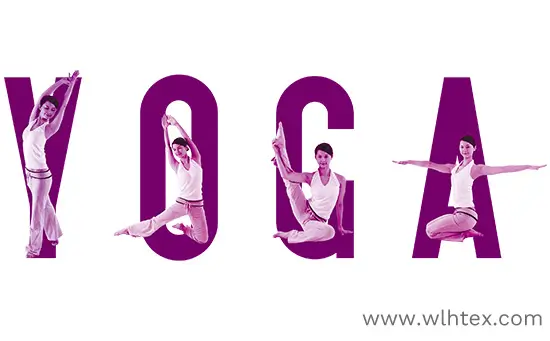A note of Yoga wear pants fabrics

Yoga wear and yoga pants is the type of clothing that you wear to practice yoga. Generally speaking, yoga clothes are divided into long-sleeved, medium-length sleeves, short-sleeved, tank tops and suspenders, while trousers are mostly straight fit trousers, flared trousers and wide-leg joggers.
Yoga wear is a type of clothing that is worn to fit the body, and as yoga can involve a lot of sweat during exercise, the material used for yoga wear is very important. There are many common fabrics used in yoga wear, the main ones being the following!
01
Quick-dry
Quick-dry fabrics are common in sportswear and are double-layered fabrics, with a non-absorbent, but porous, chemical fibre layer close to the body and an absorbent cotton blended layer on the outside. It is generally more of a chemical fibre and polyester fabric, which is more comfortable as the garment does not stick to the body after sweating.
Pros: Super volatile and absorbent, dissipates moisture and keeps you warm, keeps your skin dry and fresh, and works better in protecting against wind, rain and moisture.
Cons: Quick-drying fabrics that contain 100% polyester are not in a comfortable state as far as the human body feels when wearing them.
02
Audel Fabric
Audel fabric is a high quality fibre made from vegetable protein fibres, which are then spun through a special process, and cotton and this vegetable protein fibre are woven together to form the fabric. It is an environmentally friendly textile fabric.
Pros: good moisture absorption, moisture conductivity, elasticity, soft and breathable, draping and airy features, light and thin texture, smooth, not easy to shrink, easy to wash, quick drying.
Cons: the fabric is a natural fibre fabric, which is expensive and easy to buy as a counterfeit.
03
Modal Fabric
Modal is a cellulosic fibre, which, like rayon, is a pure synthetic fibre. It is made from wood pulp produced in the bush forests of Europe and then subjected to a special spinning process, and is now mostly used in the production of underwear.
Pros: soft touch, strong moisture absorption, bright colours, good drapability, T fabric has a natural wrinkle resistance and non-ironing feature.
Cons: poor fabric stiffness, easy to pill, high cost.
04
Cationic Fabric
Cationic fabrics are 100% polyester fabrics, generally made using cationic yarns in the warp direction and ordinary polyester yarns in the weft direction, sometimes a blend of polyester and cationic component fibres is used to achieve a better imitation of hemp.
Pros: Soft to the touch and comfortable to wear. It is very absorbent and has a low dye difference, which makes it particularly suitable for sportswear.
Cons: There are basically no disadvantages to cationic fabrics, except that they are more expensive to produce than polyester fabrics and are easily replaced by yarn-dyed fabrics.

05
Lycra Fabric
Lycra is a fabric made from spandex (short for Spandex polyurethane), also known as “lajia” (Cantonese pronunciation of lycra) in the Cantonese region and sometimes directly as “spandex fabric” in the mainland.
Pros: It is stretchy and does not deform easily. Adding Lycra to the fabric enhances the elasticity of the fabric and it can be used in combination with a variety of different fibres without changing the appearance or texture of the fabric. The fabric is very soft.
Cons: Lycra must be blended with other fibres, otherwise it is not possible to produce a final fabric.
06
Bamboo Fibre
Bamboo fibre fabric is a new type of fabric made from bamboo by a special process and woven from bamboo fibre. It is a truly natural and environmentally friendly green fibre.
Pros: smooth and soft warmth, moisture absorption and breathability, antibacterial, anti-UV, warm in winter and cool in summer, natural beauty effects of bamboo, natural anti-mite, anti-odour and anti-insect features create negative ion, natural health care, green and eco-friendly.
Cons: short lifespan; after a period of use, the cotton coils tend to shed and lose their original softness and warmth, becoming dry and hard; breathability and instant absorbency gradually diminish after use.
07
Viscose
Viscose fabric is a fabric made of viscose fibre by weaving, with soft, smooth, breathable, anti-static and gorgeous dyeing features.
Pros: soft, smooth and cool to the touch, breathable. Excellent anti-static effect, no feeling of adhesion to the body and therefore very smooth, particularly suitable for sportswear.
Cons: easy to deform, heavy feel of viscose fibres, poor elasticity and easy to crease and not very flexible.
08
Nylon
Nylon, the scientific name for polyamide fibres, a generic term for polyamide fibres produced in China. Nylon fabrics are very hard-wearing and durable, absorb moisture well and are lightweight fabrics.
Pros: excellent elasticity and elastic recovery, the highest abrasion resistance of all types of fabrics, many times higher than other fibre fabrics of the same type, therefore, its durability is excellent.
Cons: easy to deform under small external forces, so its fabric is easy to become wrinkled while wearing. Heat and light resistance are poor. Care must be taken in the process of laundering and maintenance to avoid damage to the fabric.
Yoga is a rather stretchy and restorative sport. It is about the harmony between man and nature, so you can’t be sloppy when it comes to yoga outfits. If you choose a garment with a bad fabric, it may tear when you do stretching exercises, and it may be deformed and a wardrobe malfunction might unfortunately occur. So you must pay attention to what fabric you are wearing for yoga.



